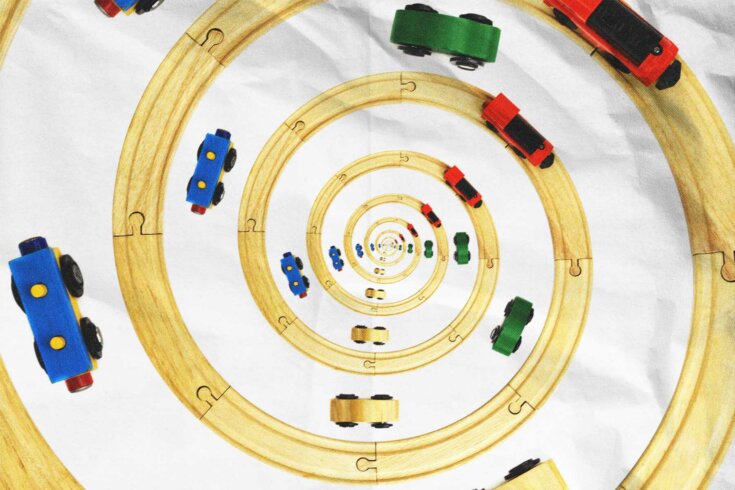
If you’ve taken a train lately, you’ve likely been late. In the third quarter of 2023, 50 percent of Via Rail train trips ran on time. And a train trip isn’t much faster than driving; the average train trip between Montreal and Toronto, the most popular one in Canada, takes five hours and eight minutes, while it would take half an hour longer to drive the same distance. Those few minutes shaved off don’t come cheap—the price of a train ticket from Toronto to Montreal changes depending on the time of year, but a round trip can run you upward of $300. Economically speaking, you’re better off driving yourself.
But trains offer an ease of travel other forms of transportation can’t provide. Being able to board a train that shuttles between the downtown cores of different cities without braving long security lines or paying for airport parking is a boon. But while Canada has an extensive rail network, it’s also the only G7 country without a high-speed option—in Japan, China, France, Spain, Italy, and the United States, trains that can reach speeds of over 450 kilometres an hour have been a reality for over a decade.
Canada has, instead, become a world leader in commissioning studies on high-speed rail. Two major corridors are seen as the most likely candidates: Windsor to Quebec City and Calgary to Edmonton. While studies have found that high-speed rail networks in these corridors could boost business and tourism as well as help reduce carbon emissions from cars and airplanes, plans are inevitably always shelved once studies reveal the financial commitments associated with building them. The cost for various high-speed rail projects has been estimated between $6 and $40 billion. (A high-speed rail project in California was supposed to cost $30 billion but quickly blew past initial projections. It could end up costing $130 billion.)
High-speed rail is also a popular campaign pledge. Beginning in the mid-2000s, premiership hopefuls like Ontario’s Kathleen Wynne and Alberta’s Alison Redford as well as Liberal leaders such as Michael Ignatieff and Stéphane Dion all promised high-speed rail during their campaigns, but the trains have never materialized.
But to others, the significant financial investment only underscores the reality: high-speed rail would be among the largest and most expensive mega projects in the country’s history and would do little to solve the existing issues plaguing Canada’s train networks.
For starters, high-speed rail is logistically impossible in Canada. Via Rail, the Crown corporation that operates Canada’s national passenger infrastructure, owns only about 3 percent of the tracks its trains run on. The rest are owned mostly by freight rail companies like CN Rail which have little incentive to lend Via a right of way along their tracks. Not having ownership over its right of way has created severe problems for Via Rail’s existing services, because they are not prioritized on the railways. If freight trains are running on the same track, a theoretical high-speed passenger train would not be able to reach the speeds that it is built for.
Second factor: density. France has been successful in building significant rail lines between major cities with significant urban density without the trains needing to stop frequently in smaller metropolitan areas. The high population density of French cities like Paris and Lyon creates enough demand to make the trains worth running, and the trains were built to accommodate that demand. Canadian cities tend to be less densely populated than many of their counterparts in the United States and Europe, so there likely wouldn’t be enough customers to make high-speed rail a profitable investment.
In the Windsor–Quebec City corridor, Canada’s most populated region, previous proposals for high-speed rail have struggled to grapple with the political pressure that would come from municipalities being passed over. Adding more stations would only reduce the advantage of high-speed rail, as more stops along the route would result in slower speeds. Inevitably, many places would not have rail stops.
One proposal that is currently on the table is a major investment along the Windsor–Quebec City corridor, which serves the vast majority of Via Rail’s services. But what the federal Liberal government is proposing is high-frequency rail, initially projected to cost between $6 and $12 billion, though the ministry of transportation has recently been unclear on the true cost. According to this proposal, the government would build new tracks along the existing line owned by Via Rail and supply faster electric trains. These would cut service times between stations, increase the number of trains, and significantly reduce delays.
But high frequency should be clearly distinguished from high speed. You could consider it to be a classic Canadian compromise—where travel times and delays could potentially be improved but without the speed or technology that European and Asian countries have enjoyed for decades. The project includes many promising improvements to rail travel in Canada but will not reduce travel times significantly (the average trip between Toronto and Montreal would be reduced by about an hour and between Ottawa and Montreal by only twenty minutes).
While faster trains and more punctual performances are certainly a welcome investment, a lack of public support and political will makes investing in a true high-speed rail option seem like an expensive risk at best. Without a public to demand a serious conversation about our relationship to the railways, a Canadian high-speed option will stay grounded.







